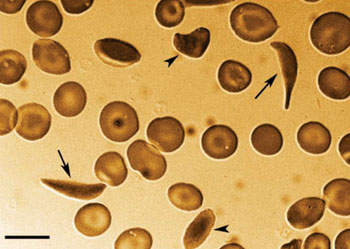Novel Device Measures Stiffness and Stickiness in Erythrocytes
By LabMedica International staff writers
Posted on 13 Mar 2016
In sickle cell disease (SCD), hemoglobin molecules polymerize intracellularly and lead to a cascade of events resulting in decreased deformability and increased adhesion of red blood cells (RBCs). Decreased deformability and increased adhesion of sickle RBCs lead to blood vessel occlusion, known as vaso-occlusion, in SCD patients. Posted on 13 Mar 2016
Red blood cells (erythrocytes) containing normal hemoglobin are flexible and shaped like a doughnut with a thin flat area in the middle instead of a hole. This allows them to squeeze round bends in blood vessels and through smaller ones to deliver vital oxygen to tissues and organs. However, sickle hemoglobin has a tendency to form stiff rods inside the red blood cell, changing it into the crescent or sickle shape that gives the disease its name.
Scientists at Case Western Reserve University (Cleveland, OH, USA) used a microfluidic approach integrated with a cell dimensioning algorithm to analyze dynamic deformability of adhered RBC at the single-cell level in controlled microphysiological flow. They measured and compared dynamic deformability and adhesion of healthy hemoglobin A (HbA) and homozygous sickle hemoglobin (HbSS) containing RBCs in blood samples obtained from 24 subjects.
The microfluidic system is composed of a Poly(methyl methacrylate) (PMMA) cover, a double sided adhesive (DSA) layer, and a glass slide base. Microfluidic channels are functionalized with fibronectin, which mimics the microvasculature wall in a closed system and can process whole blood. Adhered sickled RBCs deform in microfluidic channels in response to applied flow shear stress. By assessing the extent of stiffness and stickiness, or the "dynamic deformability and adhesion," of red blood cells, the new microfluidic device offers great potential as a way to monitor progression of sickle cell disease. Other ways to measure stiffness and stickiness in red blood cells, such as atomic force microscopy and optical tweezers do exist, but they do not lend themselves to working with whole blood in a clinical setting.
To assess dynamic deformability of red blood cells, the investigators used what they call a dynamic deformability index (DDI), which they define as "the time-dependent change of the cell's aspect ratio. Essentially, a cell's DDI is a measure of how quickly it springs back to its normal shape after experiencing flow shear stress. The team describes a range of tests where they measured the DDI of deformable and non-deformable red blood cells. They also compared adhesion of deformable and non-deformable red blood cells from blood samples taken from sickle cell patients. They tested the stickiness of the cells under different flow shear stresses, both within and outside ranges experienced in normal blood vessels.
The scientists showed that DDI of HbSS-containing RBCs were significantly lower compared to that of HbA-containing RBCs. Moreover, they observed subpopulations of HbSS containing RBCs in terms of their dynamic deformability characteristics: deformable and non-deformable RBCs. Then, they tested blood samples from SCD patients and analyzed RBC adhesion and deformability at physiological and above physiological flow shear stresses. They observed significantly greater number of adhered non-deformable sickle RBCs than deformable sickle RBCs at flow shear stresses well above the physiological range, suggesting an interplay between dynamic deformability and increased adhesion of RBCs in vaso-occlusive events. The study was published on February 19, 2016, in the journal Technology.
Related Links:
Case Western Reserve University
















